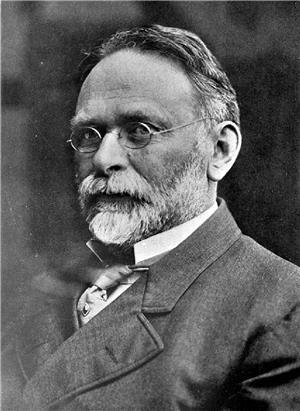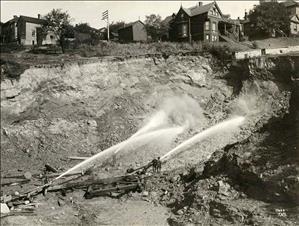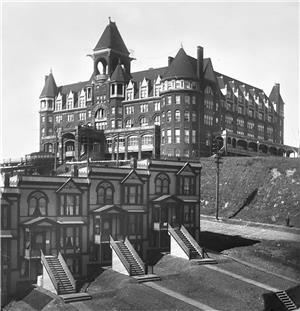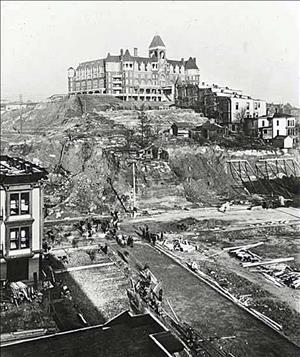The Regrade Disasters
By Michael Herschensohn
The following is the third in a series of guest blog posts submitted by members of the Historic Seattle community. The views and opinions expressed in guest posts are those of the authors and do not necessarily reflect the positions of Historic Seattle.
If you have an idea for a future post, please send a draft to info@historicseattle.org. You can review the guidelines here.
Between 1929 and 1930, a wee bit of Queen Anne (that part east of 5th Ave. N., west of 9th Ave. N. and bound by Denny Way on the south and Broad St. on the north) got washed into Elliott Bay as part of the third Denny Regrade. Our bit formed the northeast corner of the project. The lowering of Denny Park, the city’s first park, was a big part of the work even though purists will say the park isn’t in Queen Anne at all!
I’ve known that for a very long time and ever since I moved back to Seattle in 1985, I’ve wondered why. Stumbling on a paper written some 42 years ago, I discovered the reason. Having returned in my first old age at age 36 to graduate school to study historic preservation planning and architectural history, I took Seattle as the subject of many assignments. After all, I had just spent four years teaching at the UW, so Seattle history became my go to topic.

R.H. Thomson, courtesy of Paul Dorpat
I prepared that paper (“The Denny Regrade”) for a class in the history of American urban planning with the dean of the field, Professor John C. Reps. My paper traced the history of the regrade projects. The first one took place between 1898 and 1899 when city engineer Reginald Heber Thomson (1856-1949). convinced city officials to remove a portion of the hill on the north end of Seattle’s downtown. Thomson had been the city engineer for nearly a decade when the project began. He was obsessed with fostering the city’s economic growth and sure that expanding the business district out of the pit in which he saw it trapped would help the city grow. Thomson defined the pit as the land between the mud flats south of Yesler Way and Denny Hill.

Washing the hill away, courtesy of the Seattle Public Library
The first regrade washed away First Avenue from Pine Street to Denny Way. The second regrade (1903-1911) took down Denny Hill from Second Avenue to Fifth between Pike and Cedar. The third one occurred between 1928 and 1930 as a nutty response to the second one after it failed to increase land values or attract the energy of the burgeoning central business district. Some say Thomson was a visionary. I see him in the same class as robber barons, those stubborn autocrats set on getting their way whatever the consequences. I forgive Thomson because his bull-headed behavior was well intended and didn’t make him rich. To be perfectly fair, Thomson had nothing to do with the third regrade. He’d moved on long before it began.
Hydraulic sluicing Seattle’s soft clay made the regrade projects easy to do. The sluices were, by the way, a common strategy for moving wet earth and were part of Seattle’s culture following the Klondike Gold Rush where stream beds were diverted through sluices to strain them for gold. By the time of the third regrade, the work got easy. Rubber conveyor belts moved the washed-out dirt to Elliott Bay where cleverly designed barges dumped it. Filled with dirt falling from the belt, the double-sided barges were towed out in the bay where they flipped over, dumped their loads and presented an empty bin ready for refilling at the shore.

The Denny Hotel in 1903, courtesy of Paul Dorpat
It seems fair to say that except for dumping tons of dirt into Elliott Bay and leveling a very big hill, the regrades flopped terribly. They did practically nothing to improve the economic vitality of the city until almost a century later when Amazon finally redeveloped that big chunk of the third regrade between 6th and 8th avenues. It is Thomson’s failure to see the possibility of the regrades failing economically that interests me.
The first regrade set the stage for the second. James Moore, owner of the huge Washington Hotel on top of Denny Hill, resisted the regrade concept that Thomson touted. Moore had bought the unfinished Denny Hotel at the tippy top of the hill from Arthur Denny, renamed it the Washington Hotel and completed it at considerable expense.

The Washington Hotel on Denny Hill after the first regrade, courtesy of MOHAI
Moore balked at tearing down his hotel and his substantial portion of the hill, but Thomson charged ahead with the first regrade making Moore’s hotel pretty inaccessible. When Moore caved in, Thomson moved forward with the second regrade. The top of the hill and the hotel began to disappear in 1906. About the same time, Moore built a new hotel, the New Washington, at Second and Stewart (today’s Josephinum) and the Moore Theatre next door. Both were completed in advance of the 1909 Alaska-Yukon-Pacific Exposition, the world’s fair held on the UW campus.
Stretching roughly from First Avenue east to Fifth and from Pike north to Cedar, the second regrade leveled about 170 feet of Denny Hill. For comparison purposes, it stood a little bit more than one third as high as Queen Anne Hill (436 feet) today. As Walt Crowley tells it, the failure of the first regrade was driven partially by being butted up to the second half which provided a dismal backdrop to the new flatlands of Belltown. Crowley also points to two other factors that stymied the redevelopment of the regrades. Both can be attributed to poor thinking by Thomson or his arrogance.
Crowley politely contends that Thomson could not have anticipated the advent of the automobile which made close in development of the city less necessary and that he had no way to understand the impact of skyscrapers such as the Smith Tower (completed in 1914). Skyscrapers increased the density of offices in the historic core and like the automobile reduced the need to expand over the land.
I’d agree that Thomson’s timing was off, but skyscrapers were already dotting New York and Chicago. Seattle got its first skyscraper, the Alaska Building, in 1904, just about the time of the second regrade, the big one, got underway. Were he the far-thinking urban planner local historians have seen in him, he would have understood the future of very tall buildings. Maybe his rural Ohio roots blinded him to this urban potential. As for the automobile, Crowley may be right. There were only a couple of thousand cars in the state when the second regrade began. The automobile was still very far from its polluting heyday, and no one could have anticipated its impact on urban sprawl. In fact, we still haven’t figured out how to manage it.
The system embraced for financing the regrades may have been the final nail in the coffin. To finance the work, the city adopted a local improvement district, a LID, just like the one recently imposed on downtown businesses to fund improvements along the waterfront. Property owners in the regrades were taxed to pay for the work under the assumption that the improvements, the lowering of the hills, would increase property values and make them rich.
It just didn’t work out that way. The new flat land of the second regrade was unnecessary and ugly. Without the need for fancy stores, homes or hotels in the new neighborhood, flop houses, bars and some tenements moved in. At the very same time Paris and New York were identifying unhealthy neighborhoods for their ultimate removal, Seattle built one.
Thomson tried to remedy the problem with the second regrade by washing the hill he’d left behind into the bay. The outcome was nearly as bad. The flop houses, bars and single room only apartments only spread. Eliminating the eastern portion of hill gave license to the down and out character of the first regrade to spread unchecked. My guess is that Prohibition didn’t hurt either.
The third regrade completed between 1928 and late 1930 eliminated what remained of the hill. Eventually, the bulk of it was bought up by the Clise family, Seattle’s most well-known real estate developers. As late as 2008, the Clise property was the largest contiguous inner-city tract of land in the United States, larger even than New York City’s 22-acre Rockefeller Center.
Now, long after I wrote that paper for John Reps, I worry about the people in government making unchallenged decisions that are transforming our world. At the end of 19th c., Thomson convinced city officials to undertake a project that transformed Seattle. Until Amazon’s recent purchase of broad swaths of the third Denny Regrade, the northern portions of Seattle’s business district were a disaster, lying fallow for over 100 years. In reviewing my paper, my fear of simply accepting the wisdom of people in power is confirmed. Of course, Thomson did some great things for Seattle, particularly the Cedar River watershed project which still provides our clean drinking water, but he garnered too much power. His biggest ideas went unchallenged, and some, such as the Denny Regrades, bore rotten fruit.
Michael Herschensohn trained in architectural history and preservation planning at Cornell University. He served on the Historic Seattle Council for nearly 30 years. Michael continues volunteer preservation work as president of the Queen Anne Historical Society where he regularly writes about the fabric of his neighborhood’s built environment. This piece originally appeared on the QAHS website.